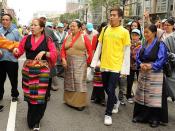Significant Concept: Goldstein's article focuses on the overlap between the domestic group, defined as those individuals that live in a single household together, and the kin group, or people who view themselves as relatives, within a certain Tibetan society near Limi, Nepal. According to the article, the idea of polygyny - the taking of more than one wife by a single man - is practiced by consanguine brothers for primarily economic reasons in addition to reasons of tradition. Because of the time requirement of the subsistence economy, a man setting up a monogamous household would find it difficult if not impossible to farm, manage the animals, and care to his husband duties. The author likens the practice to the former Western practice of primogeniture, or land granted to the eldest male heir, that was practiced in the last century. Goldstein further explains that the form of bride-sharing that is practiced allows the brothers to enjoy a "more secure and higher standard of living", as each man would retain access to the family estate and property rather than dividing it amongst all the familial heirs.
In this same context, the article provides the reduction in population growth (and "reduction on the resources" as well) polyandry provides as another possible, though largely discounted, reason for the practice. Because the soil is arid and largely infertile, only select areas of terraced land are available as farmland to the Tibetans. The infertility of the soil coupled with the harsh Himalayan climate introduces a seeming carrying capacity of the region; that is, there seems to be a limit to how large a population the land can support. The article concludes by discussing the decline of polyandrous marriages, and even goes so far as to describe that the practice may be completely gone within a...


